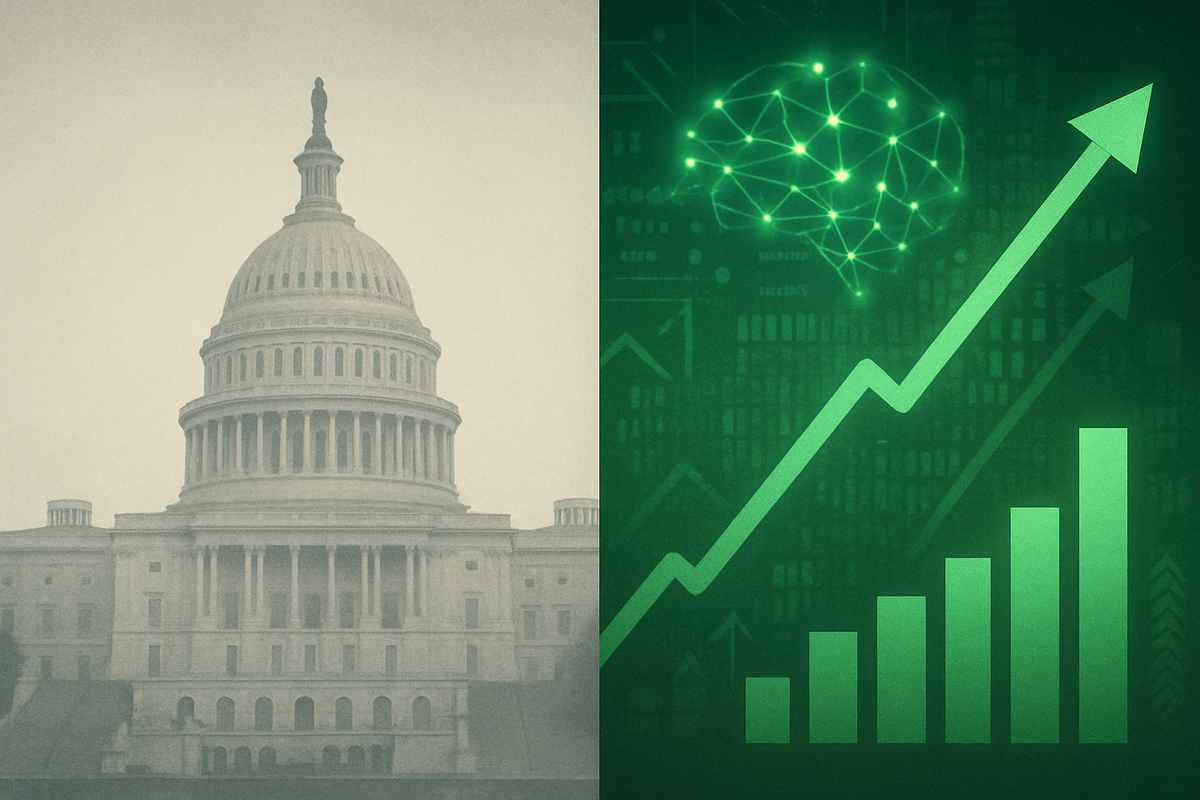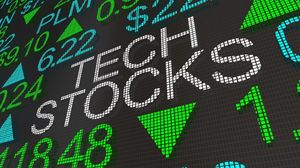S&P 500 Defies Washington Gridlock, Extends Historic Winning Streak Amidst Government Shutdown

As the United States government enters its second week of shutdown, a remarkable divergence is playing out on Wall Street. While political pundits grapple with congressional gridlock, the S&P 500 has soared to unprecedented heights, marking an extraordinary eighth consecutive day of gains as of October 7, 2025. This impressive green streak, a rare occurrence in market history, directly contrasts with the usual apprehension surrounding government closures, painting a vivid picture of investor resilience and a surprising market reaction that suggests a market increasingly detached from Washington's political drama.
Historically, the stock market's response to a government shutdown has often been muted, with data indicating these events typically have a modest impact, particularly if brief. However, the current market fervor goes beyond merely shrugging off political instability. An eight-day consecutive "green streak" for the S&P 500 is a noteworthy event, with such robust winning streaks often heralding broader market rallies. As the S&P 500 continues its upward trajectory in the face of federal paralysis, investors are left to ponder whether this unusual blend of political stagnation and market exuberance signals a new paradigm of economic detachment or simply a testament to underlying fundamental strengths.
Unpacking the Market's Unfazed Ascent
The current government shutdown, triggered by a failure in Congress to pass appropriations bills for the 2026 fiscal year, commenced on October 1, 2025. This marks the ninth shutdown since 1982, highlighting a recurring feature of U.S. politics. Despite the gridlock, the S&P 500 has not only remained resilient but has rallied to new record highs, reaching a live value of 6,740.29 USD on October 7, 2025, extending an impressive eight-session winning streak. Futures for the S&P 500 also gained 0.3% as the shutdown entered its second week, reflecting continued investor confidence despite political deadlock.
This unexpected market robustness is largely attributed to a fervent optimism surrounding artificial intelligence (AI) and positive corporate announcements, effectively overshadowing the shutdown's uncertainties. The market appears to be looking past temporary disruptions, focusing instead on technological advancements and corporate earnings. However, this period of federal paralysis has immediately halted the release of crucial economic data from agencies like the Bureau of Labor Statistics and the Census Bureau, including official jobs reports, CPI, and GDP revisions. This "data blackout" leaves both investors and the Federal Reserve "flying blind," complicating monetary policy decisions and creating uncertainty around future interest rate adjustments.
Key stakeholders, including approximately 900,000 federal employees who may be furloughed and another 700,000 working without pay, face immediate financial pressure. Government contractors, particularly smaller ones, also face significant disruptions, lost revenue, and cash flow issues due to payment delays and project halts. Historically, the S&P 500 has shown remarkable resilience during shutdowns, posting positive returns in 17 of 18 shutdowns since 1976. For instance, during the 14-day October 2013 shutdown, the S&P 500 gained 3.1%, and even during the longest shutdown (35 days from late 2018 to early 2019), the index ultimately posted positive returns, rising 9.3% despite initial declines, driven by a dovish shift from the Federal Reserve. This historical pattern reinforces the market's tendency to view these events as temporary political noise rather than fundamental economic threats.
Winners and Losers in a Shutdown Rally
A U.S. government shutdown creates a complex environment for public companies, with impacts varying significantly across sectors. An unexpected S&P 500 rally during such a period indicates that broader market sentiment is strong enough to mitigate some negative effects, but specific operational challenges remain.
Sectors most negatively affected include Government Contractors and IT Services. Companies like Maximus Inc. (NYSE: MMS), which provides health and human services programs, and CACI International Inc (NYSE: CACI), an IT solutions provider to federal clients, face immediate risks from funding halts, payment delays, and project suspensions. These companies could see their stock prices partially cushioned by the overall market rally, but their operational and cash flow challenges due to delayed federal payments would persist.
The Travel and Hospitality sector is also highly vulnerable. Closures of national parks and federal museums, coupled with potential disruptions in air travel due to essential personnel working without pay, lead to substantial economic losses. Airlines such as Southwest Airlines Co. (NYSE: LUV) and hotel chains like Marriott International, Inc. (NASDAQ: MAR) would experience reduced bookings and demand. While the S&P 500's rally might prevent a deeper stock price decline, the fundamental hit to their revenue streams in affected areas remains.
Regulatory-Dependent Industries, including biotech, energy, and financial services, face significant hurdles. Agencies like the FDA, EPA, and SEC operate with minimal staff, leading to delays in approvals for drug trials (impacting companies like Moderna, Inc. (NASDAQ: MRNA)), environmental permits (affecting Exxon Mobil Corporation (NYSE: XOM)), and IPOs or mergers. These delays can halt product launches and business expansions, irrespective of the broader market's performance.
Conversely, certain sectors tend to be less affected or could even benefit. Large Defense Contractors like Lockheed Martin Corporation (NYSE: LMT) and Northrop Grumman Corporation (NYSE: NOC) often weather shutdowns relatively well due to long-term contracts and national security priorities, which often shield their funding. Their stable operations, combined with a rallying market, could see their stock values further appreciate. Consumer Staples companies, such as Walmart Inc. (NYSE: WMT) and Procter & Gamble Co. (NYSE: PG), provide essential goods, which remain in demand even during uncertainty, making them defensive plays that would benefit from overall market positivity. Furthermore, Precious Metals like gold, and thus gold miners like Newmont Corporation (NYSE: NEM), typically benefit from increased demand as safe-haven assets during periods of political uncertainty, with the market rally further supporting their appreciation. Finally, Technology Companies with diversified revenue streams and minimal direct government exposure, like Microsoft Corporation (NASDAQ: MSFT) and Apple Inc. (NASDAQ: AAPL), are often resilient, especially given the current AI-driven market euphoria, and would see their positive momentum amplified by the S&P 500's ascent.
The Broader Canvas: Disconnect and Divergence
The S&P 500's eight-day rally amidst a government shutdown in October 2025 is highly significant, highlighting a growing disconnect where investors are prioritizing strong corporate fundamentals, technological innovation, and anticipated monetary policy shifts over political drama. This event serves as a testament to the market's resilience and its capacity to look through the noise of Washington's stalemates.
This unusual strength is deeply embedded in broader market trends. Fervent AI-driven optimism continues to be a primary catalyst, fueling significant investments and pushing valuations higher in technology-focused companies. The anticipation of further interest rate cuts by the Federal Reserve also boosts investor sentiment, making equity investments more attractive. Despite broader economic uncertainties, corporate earnings resilience provides a strong foundation. This creates a "two economies" phenomenon, where the Wall Street economy, driven by institutional capital and high-net-worth individuals, responds to interest rates and technological breakthroughs, seemingly detached from the "Main Street" economy, where average citizens might feel the brunt of economic disruptions.
The ripple effects of this dynamic are considerable. For government-dependent competitors and partners, the shutdown means continued operational challenges, even as the market rallies. However, the AI ecosystem and less government-exposed sectors see amplified benefits. On the overall economy, a prolonged shutdown could reduce GDP growth by 0.1 to 0.2 percentage points per week, primarily from furloughed federal workers' pay loss and delayed federal spending. Regulatory functions across various agencies slow considerably, creating operational challenges for businesses awaiting approvals. The "data blackout" during a shutdown creates an information vacuum, which could lead to information asymmetry, benefiting large institutions with proprietary data.
Historically, while government shutdowns have resulted in mixed S&P 500 performance, markets have generally shown resilience. However, analysts warn that liquidity-driven rallies that ignore economic fundamentals can resemble "melt-up" phases that preceded major market corrections, such as the dot-com bubble of 2000 and the lead-up to the 2007 financial crisis. The current market, with its AI enthusiasm and high valuations, is drawing some comparisons to such periods, raising concerns about potential overvaluation.
What Comes Next: Navigating the Uncharted Waters
The current confluence of a government shutdown and a rallying S&P 500 presents a complex outlook for the coming months. In the short term, the market's resilience, fueled by AI optimism and corporate earnings, may continue, with investors potentially viewing any dips as buying opportunities. However, the longer the shutdown persists, the greater the risk of increased volatility and a re-evaluation of market fundamentals. The delayed release of crucial economic data means the Federal Reserve is "flying blind," complicating monetary policy decisions and potentially leading to missteps regarding interest rates.
For companies, strategic pivots are becoming increasingly critical. Businesses heavily reliant on federal contracts must urgently diversify revenue streams and develop robust contingency plans for regulatory delays. Supply chain adjustments may be necessary to mitigate disruptions from halted government inspections or certifications. More broadly, companies might become more conservative with capital expenditures and hiring decisions, or even explore international markets to reduce susceptibility to U.S. political gridlock. Investment in automation could also gain traction as a way to mitigate workforce disruptions.
Market opportunities could continue to emerge in the AI and tech sector, though valuation risks are present. If economic impacts deepen, a rotation into more defensive stocks (e.g., healthcare, utilities) might occur. Gold and quality fixed income could also serve as safe havens. Conversely, challenges include increased volatility, information asymmetry due to data blackouts, and the risk of overvalued assets in a "melt-up" scenario. Sectors heavily reliant on government contracts or regulatory approvals will continue to face immediate selling pressure and operational disruptions.
Potential scenarios for investors range from a short-lived shutdown with minimal lasting impact, leading to continued market gains, to a prolonged impasse causing significant economic drag and a re-evaluation of market fundamentals. A "worst-case" scenario involving permanent federal layoffs and unresolved fiscal issues could inflict severe and lasting damage, potentially leading to a sustained market downturn and a questioning of U.S. fiscal stability by international investors.
The Resilient Market: A New Paradigm or a Precarious Peak?
The S&P 500's unprecedented eight-day green streak amidst a U.S. government shutdown as of October 7, 2025, serves as a powerful testament to the market's evolving resilience and its capacity to look beyond immediate political noise. Key takeaways underscore a market driven by fervent optimism around artificial intelligence, strong corporate earnings, and the anticipation of favorable monetary policy, rather than being derailed by Washington's gridlock. While historical precedents suggest government shutdowns often have a modest and temporary impact, this particular event highlights a potential disconnect between a booming Wall Street and a potentially struggling Main Street.
Moving forward, the market's trajectory will hinge critically on the duration and depth of the shutdown. A swift resolution would likely reinforce the current optimistic sentiment, allowing the underlying fundamental drivers to continue propelling growth. However, a prolonged impasse risks eroding consumer and business confidence, leading to more significant and potentially unrecoverable economic consequences, including the possibility of permanent federal job cuts.
The lasting impact of this event will be determined by whether the market's current defiance represents a new paradigm where political instability is increasingly marginalized by technological progress and corporate strength, or if it's a precarious peak built on speculative fervor. Investors should closely watch for the resolution of the shutdown, the resumption of reliable economic data releases, and the Federal Reserve's subsequent policy actions. Continued corporate earnings performance and further developments in AI will also be crucial indicators. In these uncertain times, maintaining a diversified portfolio, understanding the specific drivers of current market momentum, and being prepared for various outcomes will be paramount for investors in the coming months.
This content is intended for informational purposes only and is not financial advice
More News
View More




Recent Quotes
View More
Quotes delayed at least 20 minutes.
By accessing this page, you agree to the Privacy Policy and Terms Of Service.